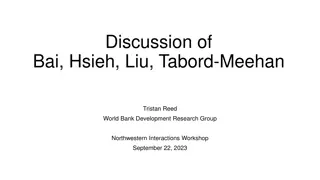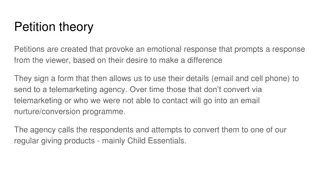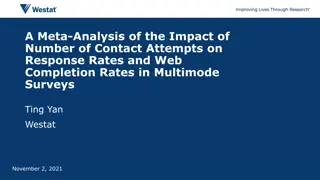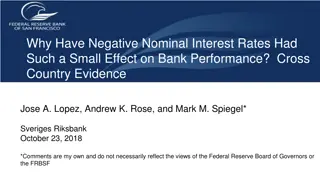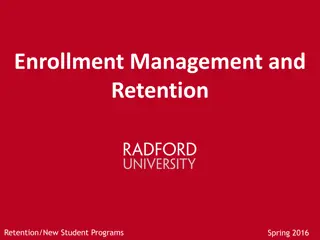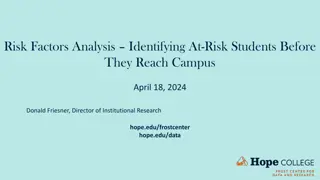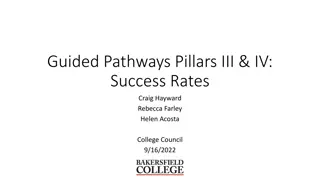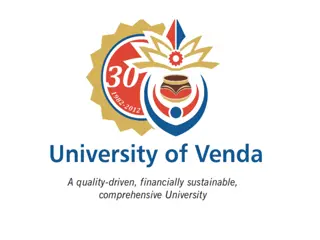Leveraging Affordable Technology for Addressing Staffing Challenges in Emergency Services
Discover how automated dispatch processes can help emergency service centers manage dispatcher workload, improve response times, and enhance situational awareness. Learn about the benefits of integrating affordable technology to streamline operations and ensure faster, safer alerting for fire statio
0 views • 14 slides
Discussion of Randomized Experiments and Experimental Design Challenges
Randomized experiments face statistical power challenges due to rare outcomes and high variance. Stratifying randomization can help control for correlated residual variance based on baseline values of outcomes. Implications for applied economists include addressing attrition and treatment effect het
0 views • 6 slides
Understanding Teacher Well-Being: Challenges and Solutions
Dive into the current landscape of teacher well-being, exploring trends in satisfaction, burnout, and attrition. Discover the causes and consequences of teacher stress, along with promising approaches for enhancing teacher well-being. Uncover the pressing need for innovation in supporting educators.
1 views • 27 slides
Improving Customer Service: Challenges and Strategies in 2024
Despite rising customer demands and declining staffing levels, efforts are underway to enhance customer service in SSA. Challenges include administrative funding constraints, increased retiree numbers, and staff attrition. Strategies involve leadership changes, increased onsite presence, and perform
1 views • 7 slides
Computation of Machine Hour Rate: Understanding MHR and Overhead Rates
Computation of Machine Hour Rate (MHR) involves determining the overhead cost of running a machine for one hour. The process includes dividing overheads into fixed and variable categories, calculating fixed overhead hourly rates, computing variable overhead rates, and summing up both for the final M
4 views • 18 slides
New Mexico Graduation Rates 2018-2019 Analysis
The New Mexico Public Education Department utilizes a Shared Accountability Model to calculate graduation rates, considering students' time enrolled at each school. Graduation rates are calculated after a two-step verification process, with on-time graduates in focus. Historical data shows a positiv
0 views • 13 slides
Effective Strategy of Using Petitions and Telemarketing for Lead Generation
Utilizing emotional petition theory to generate leads through telemarketing and nurture campaigns, with the help of agencies like Social Blue, has resulted in successful conversion rates for regular giving products. Learnings show low attrition rates, maximum leads per month, and good conversion rat
0 views • 4 slides
Understanding Chemical Kinetics: Rates, Reactions, and Mechanisms
Chemical kinetics involves studying reaction rates, rate laws, stoichiometry, and factors affecting reaction speed. This branch of chemistry delves into determining reaction orders, rate constants, and activation energies using various methods. Different types of rates, such as initial, instantaneou
2 views • 68 slides
Primary Care DES: Additional Roles Future Supply Workforce and Intelligence
The Primary Care DES introduces a scheme to recruit additional staff to address workforce shortages in general practice. Various reimbursable roles are available under the scheme, aiming to enhance capacity and support recruitment across different healthcare roles. Considerations are made regarding
0 views • 13 slides
Enhancing Physics Education: Future Physics Leaders Initiative
The Future Physics Leaders program, a national education project managed by the Institute of Physics, aims to support specialist physics teachers, Newly Qualified Teachers (NQTs), and non-specialist physics teachers in England. By offering professional development, matched timetabling, and mentoring
0 views • 10 slides
Understanding Chemical Kinetics: Reaction Rates and Mechanisms
Chemical kinetics is a branch of chemistry focused on studying reaction rates and mechanisms. Unlike thermodynamics, which deals with feasibility, kinetics explores the speed at which reactions occur. Factors such as temperature, pressure, and catalysts influence reaction rates. Understanding the ra
3 views • 72 slides
Cancer Survival Rates in Europe: Trends and Disparities
Cancer survival rates in Europe have shown variations across different types of cancer and countries. While overall cancer mortality has increased over the years, some countries have experienced declines in mortality rates. Survival rates for breast cancer between 1995-2014 ranged from 74% to 89%, w
0 views • 17 slides
Understanding Coastal Landforms: Formation and Characteristics
Coastal landforms are features shaped by erosion and sedimentation processes along coastlines. These landforms, including headlands, cliffs, bays, spits, salt marshes, and beaches, are predominantly influenced by factors such as wave action, longshore currents, tides, and climatic elements like wind
0 views • 35 slides
Encouraging a Household Panel to Transition Online: Insights and Strategies
The study explores methods to incentivize a face-to-face household panel to participate online, focusing on cost savings and minimizing attrition rates. By mixing online and face-to-face data collection methods, the researchers aim to maintain data quality while reducing expenses. The experiment inv
0 views • 28 slides
Factors Affecting Undergraduate Students' Sense of Belonging in STEM Disciplines
Student attrition in STEM fields remains a critical issue, with women and underrepresented minority students facing higher dropout rates. Sense of belonging is identified as a key factor influencing retention, particularly for female and URM students. This study explores various aspects, including r
0 views • 22 slides
Enhancing Sexual Assault Investigations through Researcher-Police Collaboration
This study focuses on improving the quality of sexual assault investigations through collaboration between researchers and police chiefs in Los Angeles. It addresses issues such as downgrading of rapes, lack of investigation, and the impact of crime reporting criteria. The research aims to examine s
0 views • 16 slides
Thyroid Cancer Survival Trends in Europe: Eurocare-5 Study
A population-based study on thyroid cancer survival rates in Europe over 25 years reveals insights by sex, country, age, period, and histological type. The study shows increased incidence but stable mortality trends, with varying survival rates based on region, gender, and histology types like papil
0 views • 14 slides
Impact of Number of Contact Attempts on Response Rates in Multimode Surveys
This meta-analysis investigates the effects of the number of contact attempts on response rates and web completion rates in multimode surveys. Benefits of multimode surveys include improving coverage, increasing response rates, reducing costs, and enhancing measurement accuracy by utilizing multiple
0 views • 27 slides
Understanding Unit Rates in Mathematics
Explore the concept of unit rates in mathematics, where you will learn how to determine unit rates of given quantities and solve word problems involving unit rates. Discover key vocabulary, such as ratio, rate, and terms, and understand the difference between ratio and rates. Delve into examples and
0 views • 22 slides
Understanding Exchange Rate Behavior with Negative Interest Rates: Early Observations by Andrew K. Rose
In this study, Andrew K. Rose examines the exchange rate behavior in economies with negative nominal interest rates, focusing on the impact and implications of such rates on exchange rates. The findings suggest limited observable consequences on exchange rate behavior, with similarities in shocks dr
0 views • 42 slides
Australian Imaging Biomarkers and Lifestyle Study Overview
The Australian Imaging Biomarkers and Lifestyle Flagship Study of Ageing began in 2006 with PiB and MRI assessments. Over time, the study has expanded to include more participants and various imaging modalities. Current focuses include converting amyloid results to centiloid units, exploring blood b
1 views • 7 slides
Key Issues in Longitudinal Research Design: Insights from the Growing Up in Scotland Study by Paul Bradshaw
Longitudinal research involves observing changes over time in various entities like individuals, households, and institutions. The UK has a rich history of conducting longitudinal studies, including birth cohort studies and family panel studies. Challenges in longitudinal research include stable lea
0 views • 32 slides
Language Attrition and Professional Adaptation
Explore the challenges of language attrition and professional re-immersion, shedding light on the transfer of skills between languages, attitudes towards attrition, and the misconceptions surrounding L1 attrition in professional migrants. This study examines the impact of language change on speciali
0 views • 38 slides
Principles of Oral Diagnosis and Examination Techniques by Prof. Magdy K. Hamam
Prof. Magdy K. Hamam, a distinguished professor of Oral Medicine, outlines the principles of oral diagnosis and examination techniques in dentistry. The assessment of individual teeth, visual inspection, probing, and other evaluation methods are crucial for identifying dental issues such as caries,
0 views • 10 slides
Evaluation Methods and Challenges in Project Analysis
Examining the course provided by Shawn Cole from Harvard Business School, this content covers topics such as evaluation techniques, randomized sampling, threats in analysis, and project analysis from start to finish. It delves into key concepts like attrition, spillovers, compliance, and bias in sam
0 views • 64 slides
Optimal Timing for Differentiated Service Delivery Models in HIV Treatment: A Case Study from Zambia
Attrition rates in HIV treatment programs remain high in sub-Saharan Africa, especially within the first six months after ART initiation. This study in Zambia examines if patients with less than six months on ART should be automatically excluded from differentiated service delivery models. Routine e
0 views • 11 slides
Importance and Methods of Training in Human Resource Management
Training in human resource management plays a crucial role in enhancing employee skills, controlling attrition rates, and increasing job knowledge. This article discusses the importance of training, methods like on-the-job and off-the-job training, and specific techniques such as coaching, understud
0 views • 16 slides
Understanding Age Adjustment in Disability Statistics
Explore the significance of age adjustment in disability statistics for creating comparable figures across countries. Learn about crude versus age-adjusted prevalence estimates and the importance of standardized rates for accurate comparisons in different populations. Discover the anatomy of rates,
0 views • 22 slides
Impact of Negative Nominal Interest Rates on Bank Performance: Cross-Country Insights
Examining the effects of negative nominal interest rates on bank performance reveals challenges in maintaining profitability, with concerns around reduced interest rate margins and disruptions to monetary transmission mechanisms. Empirical evidence suggests a reluctance among banks to impose negativ
0 views • 43 slides
Insight into Student Enrollment and Retention Strategies for 2016
Delve into the challenges and strategies surrounding student retention and enrollment management in the academic year 2015-2016. Discover data on retention rates, student profiles, and the effectiveness of new student programs at RU. Gain insights into the need for faculty involvement, changes in re
0 views • 28 slides
FY21 Fringe Rates and Benefits Analysis for Research Grants
Explore the newly negotiated FY21 fringe rates for grants, historical comparisons, and the treatment of fringe benefits on grants per Uniform Guidance. The comprehensive analysis includes details on the increase in rates to recover deficits, benefits included in the fringe rates, and the process of
0 views • 14 slides
Minnesota Schools at a Breaking Point: Educator Voices Amidst Pandemic Challenges
Educators in Minnesota are facing unprecedented challenges, including systemic failures, unsafe working environments, and educator attrition. The Educator Policy Innovation Center highlights the severity of the situation, emphasizing the voice of educators and the impact on students. National trends
0 views • 10 slides
Impact of Negative Nominal Interest Rates on Bank Performance
Negative nominal interest rates, implemented following the financial crisis, have had a limited effect on bank performance globally. While low rates reduce profitability, banks have shown resilience through adjustments in funding allocations and non-interest income sources. Studies suggest that resp
0 views • 34 slides
Risk Factors Analysis: Identifying At-Risk Students Before They Reach Campus
Risk Factors Analysis aims to identify students at risk of attrition before they even arrive on campus by evaluating academic, financial, minority, and first-generation factors. The method involves choosing specific risk factors, tracking historical prevalence, calculating relative risk, and predict
0 views • 15 slides
Analyzing Success Rates and Disproportionate Impact in Academic Courses
The analysis delves into courses with low success rates, examining factors contributing to outliers and equity implications. Courses like XXXXB1A and XXXXB36 show historically poor success rates. Additionally, disproportionate impacts are observed among Black, Asian, Hispanic, and White students. Th
0 views • 8 slides
Understanding Cohort Analysis in Educational Research
Cohort analysis in educational research involves studying a group of students meeting specific criteria to analyze trends over time. Baseline data is crucial for comparison, and it helps institutions track student persistence, retention, and attrition rates. By establishing baselines, institutions c
0 views • 12 slides
Challenges in Staffing Classrooms with Qualified Teachers
The difficulty in staffing classrooms with qualified teachers is a prevalent issue in the education sector, backed by data from the Schools and Staffing Survey. High attrition rates among teachers contribute to this challenge, with turnover rates higher than many other professions. Schools often fac
0 views • 16 slides
Comparison of Graduation Rates in Federal and VFA Community Colleges
The comparison between Federal and VFA Community College graduation rates reveals differences in success percentages among different cohorts of students. Federal rates focus on first-time, full-time students after 3 years, while VFA rates consider all students after 6 years. The data highlights vary
0 views • 9 slides
Exploration of Social and Cognitive Presence in Online Learning Cohorts
Investigation conducted at San Jose State University and University of Pittsburgh compares student satisfaction in cohort and non-cohort programs. Cohorts offer a sense of community, belonging, and shared learning experiences. Limited empirical evidence exists on cohort benefits in online education.
0 views • 16 slides
Understanding Interest Rates: A Comprehensive Guide
Explore the terminology, calculation, and importance of various interest rates in our lives and the economy. Learn about measuring interest rates, real versus nominal rates, and the distinction between rates and returns. Dive into finance fields, debt concepts, time value of money, and investment va
0 views • 48 slides

